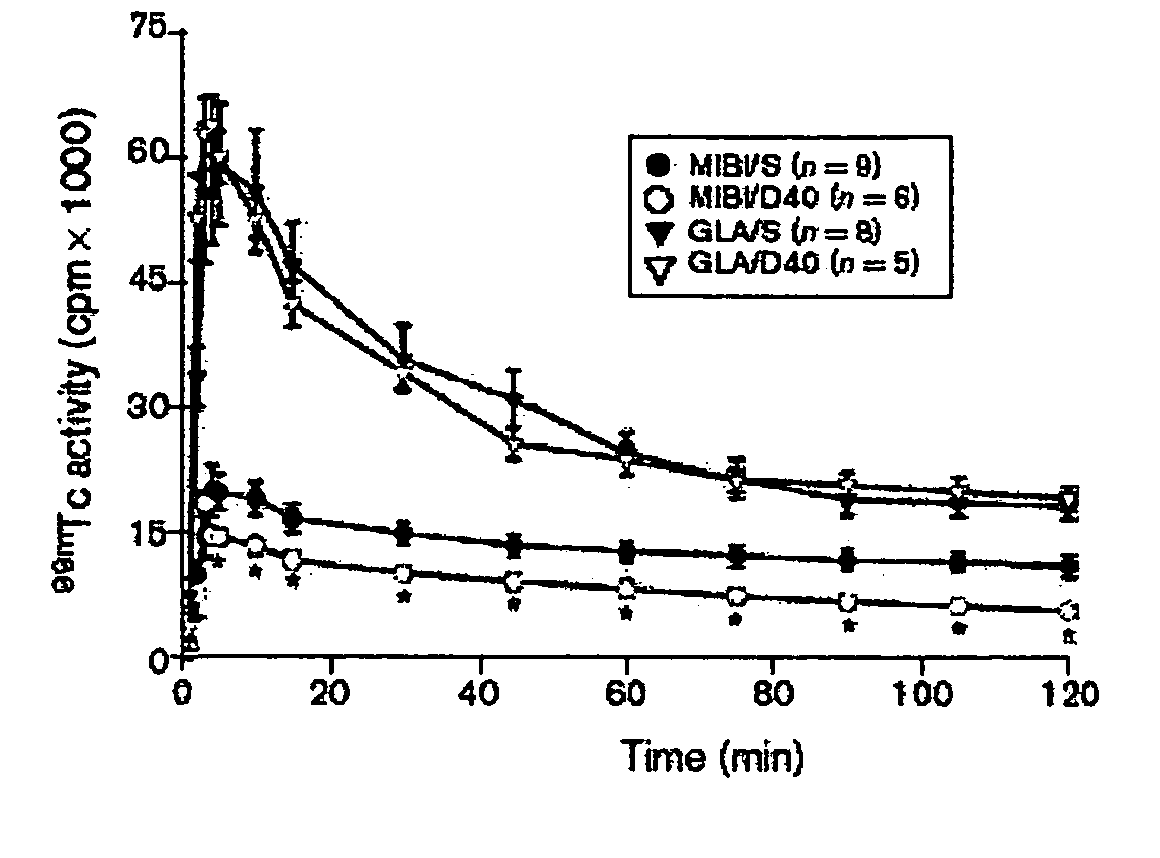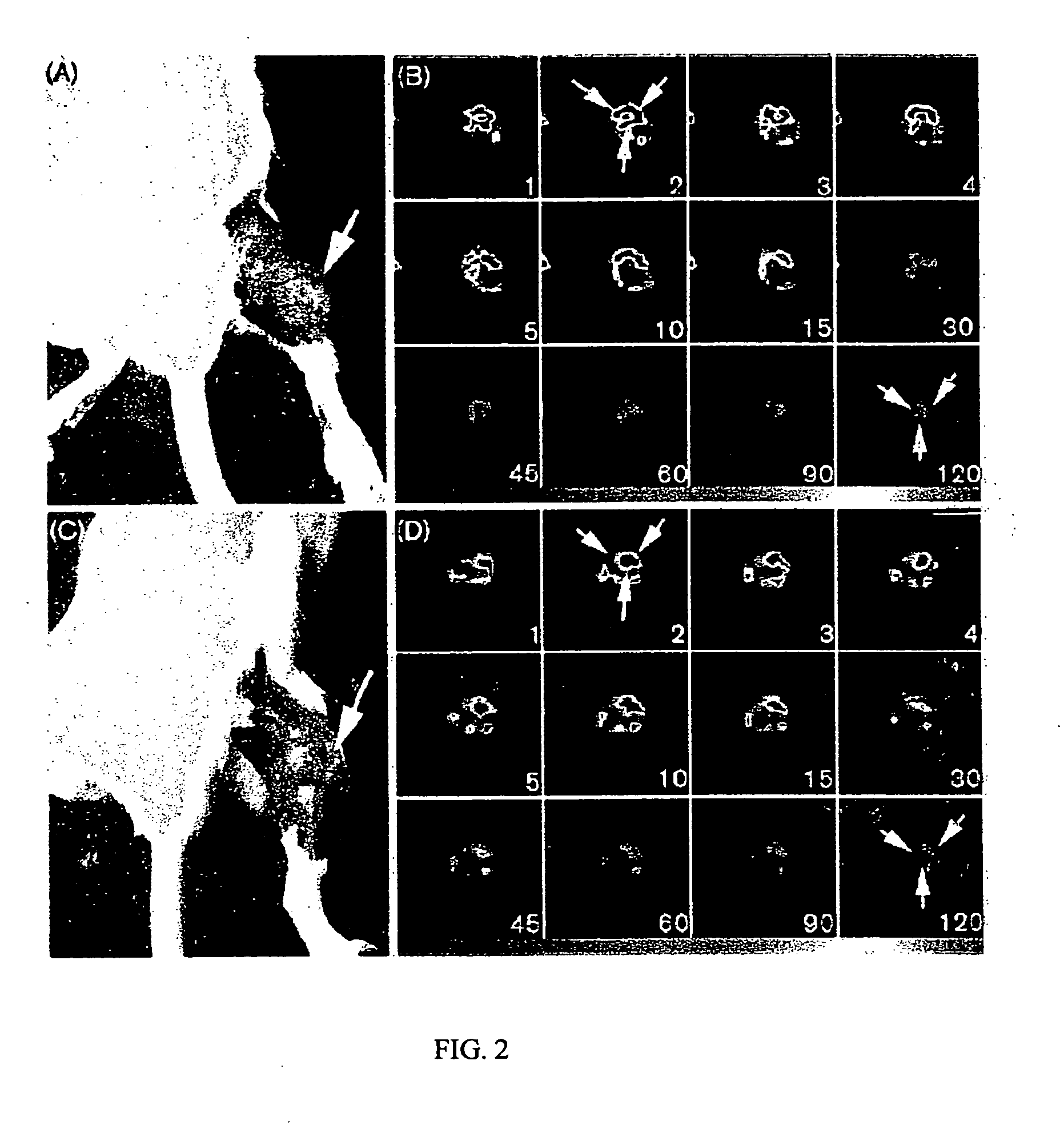Technetium-99M glucarate methods of use for monitoring tissues
a technology of tissue monitoring and glucarate, which is applied in the field of tissue monitoring using glucarate, can solve the problems of confounding diagnosis and treatment, surgical procedures, and can be used to determine the state of tissue, for example a tumor,
- Summary
- Abstract
- Description
- Claims
- Application Information
AI Technical Summary
Benefits of technology
Problems solved by technology
Method used
Image
Examples
example 1
[0072] This example shows the detection of a resistant tumor and determination of the tumor extent using a glucarate containing radiopharmaceutical, 99mTc-labeled glucarate, localized in a resistant tumor using multiple fixed detectors.
[0073] Western blot analysis indicated that human MDR1 Pgp was well expressed in the xenografted MCF7 / D40 tumors. A prominent band was observed in tumor cell membrane preparations with C219 antibody indicating Pgp expression in the MCF7 / D40 tumor samples. No immunodetectable MDR1 Pgp was presented in the xenografted MCF7 / S tumor samples.
[0074] All tumors of 99mTc-glucarate groups were initially visualized within 5 min by FASTSPECT imaging after injection of 99mTc-glucarate, and unequivocally localized within 10-30 minutes. FIG. 1 shows representative 99mTc-glucarate coronal tomographic images in a mouse with subcutaneous MCF7 / S tumor 20 minutes post injection. Dynamic 99mTc-glucarate images demonstrated that the radioactive accumulation in the MCF7 ...
example 2
[0090] This example illustrates that the amount of ischemic reperfusion preconditioning or the amount of myocardial damage in the hearts with ischemia-reperfusion can be associated or correlated with myocardial accumulation levels of 99mTc-GLA as determined by region of interest and hot spot imaging. This example also illustrates that the degree or amount of ischemic preconditioning provided by a pharmaceutical agent may be characterized or correlated with myocardial accumulation levels of 99mTc-GLA as determined by region of interest and hot spot imaging and used to characterize or select a preconditioning pharmaceutical agent.
[0091] It is not known whether this association is reflected in the degree of myocardial injury in the ischemic-reperfused hearts. The severity of a myocardial injury can be estimated by the size of infarct or amount of irreversible myocytic necrosis. In clinical patients, infarct size can be determined with several noninvasive techniques, which has signific...
example 3
[0118] In this example the properties of 99mTc-GLA in detecting xenografted human breast-tumor with multidrug resistance is shown. The in vivo kinetics of 99mTc-GLA with 99mTc-MIBI in SCID mice by imaging using a high-resolution SPECT system is also shown.
[0119]99mTc-sestamibi (MIBI) scintimammography has been shown to have clinical utility in identifying breast tumors. However, some breast tumors are difficult to detect by MIBI imaging due to a multidrug resistance (MDR) gene, which encodes for a membrane P-glycoprotein (Pgp). Pgp acts as an energy-dependent drug-efflux pump and allows transport of structurally and functionally unrelated drugs out of cells. 99mTc-MIBI as a surrogate marker of Pgp function also can be pumped out of tumor cells with Pgp expression.
[0120] D-glucaric acid (glucarate) is a six-carbon dicarboxylic acid sugar, which can be radiolabeled with 99mTc resulting in 99mTc-glucarate (99mTc-GLA). 99mTc-GLA may be an agent for detecting breast tumors. In drug sen...
PUM
| Property | Measurement | Unit |
|---|---|---|
| emission energy | aaaaa | aaaaa |
| size | aaaaa | aaaaa |
| time | aaaaa | aaaaa |
Abstract
Description
Claims
Application Information
 Login to View More
Login to View More - R&D
- Intellectual Property
- Life Sciences
- Materials
- Tech Scout
- Unparalleled Data Quality
- Higher Quality Content
- 60% Fewer Hallucinations
Browse by: Latest US Patents, China's latest patents, Technical Efficacy Thesaurus, Application Domain, Technology Topic, Popular Technical Reports.
© 2025 PatSnap. All rights reserved.Legal|Privacy policy|Modern Slavery Act Transparency Statement|Sitemap|About US| Contact US: help@patsnap.com



